Catenary
18 April 2012 22:50 Filed in: Scenery,Structures
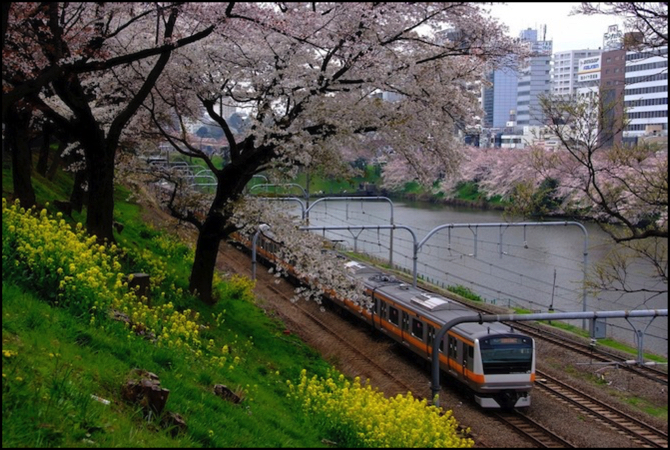
Photographer: Saitomo
It’s been two years since I last wrote about catenary, the wire above the track, which is a long time considering that my modeling is all about electric trains. In a real electric railroad, catenary is a vital component: without it there would be no power, and trains wouldn’t run. There are some model trains that can run off overhead power. But in Japanese models, the catenary is non-functional, merely a bit of scenic window-dressing. In fact the major manufacturers sell model catenary poles, but no kind of wire to string between them.
Prototype Catenary
There are some significant differences in the prototype catenary systems used in Japan. Most commuter and local trains use low-voltage DC power (typically 1500 volts, or even 750). These don’t require large insulators between the wire and the support structure, often only a couple of ceramic elements. Shinkansen, on the other hand, use 20,000 volt or 25,000 volt AC power, and this is also true of AC-powered commuter lines. With that much voltage, insulators need to be much larger, typically with a dozen or so elements
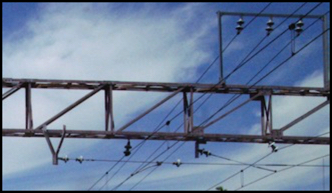
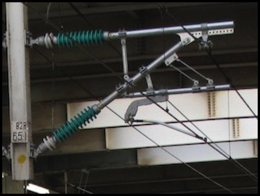
DC (left) and AC (right) Catenary and Insulators
Photographers: Hyougushi and dugspr
Also note in the two photos above how the DC catenary is simply hung from wires attached to insulators, whereas the Shinkansen AC catenary is hung from a complex cantilevered structure, which is likely due to the need to maintain the wire at a more even height, and under greater tension, to support the higher speeds in use. More complex hangers are sometimes used on DC lines, but they are much less common.
Another feature of the catenary support is provision for supporting other wires. These can include both a supply wire that feeds power directly to the catenary at intervals, as well as high-voltage lines that provide power to periodic transformers to create the supply.
Catenary structures also come in a variety of types: older structures used trusses built of straight metal elements bolted or welded together, as seen in the left picture above. New ones use tubular steel supports as seen in the photo at the top of the page. Both kinds are in use on both Shinkansen and Commuter lines. In fact, the same line may switch from one kind to another due to supports having been replaced or rebuilt along a stretch of the line. However, in general one kind will be in use along any given stretch of track.
Finally, while double track will normally have a single structure above both tracks, with two outer posts, there are some cases where two tracks run next to each other with independent structures having a single pole for each track. That’s uncommon, and probably occurs because of some local quirk of construction, but I have seen photos showing it.
Model Catenary
I’m going to be specific about Kato’s catenary pole models here, since I’m using Unitrack. Tomix also makes model catenary poles, but its double-track and multi-track catenary is designed for its 37mm track-to-track spacing, rather than Unitrack’s 33mm spacing.
Kato makes several different styles of catenary pole, but all of them are designed to fit standardized bases. The base is not typically sold with the pole, but comes separate, and there’s more than one kind. First, there are single-track poles (23-059). These have cantilevered hangers, and the insulators seem to be a compromise between high and low-voltage designs, so they could be used on either (although single-track Shinkansen lines are mainly found on mini-Shinkansen routes). They come in a set of 16 poles (eight of each style) and are designed to be used with the bases in set 23-056, which includes 16 each of single-track and single-viaduct bases.
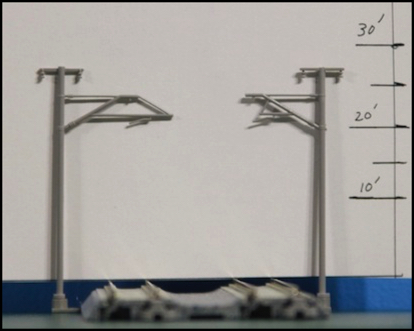
Single Track Poles used with double-track
In the photo above, note how the two arms are of different lengths. However, because the small hanger to which the wire would be attached is oriented differently, both would place the wire roughly 18mm from the center of the pole, which is also the distance of the insulator in the truss support described below.
One important point is that the bases of set 23-056 place the pole fairly close to the track. This is Kato’s older style of base, still in use for some kinds of track. But with the canted double-track they introduced a “wide” arrangement, that placed the pole further from the track to improve clearance with a tilted train (even more important when models with a tilting body are used, such as my E351 Super Azusa). The difference in design is most obvious with double-track viaduct, where the narrow poles are inside the viaduct walls, attaching to their bases through holes in the viaduct floor, and the wide bases put the poles outside the walls.
Most of Kato’s poles are designed to look like the common style of concrete pole, which supports a metal truss assembly that spans the tracks. Some, however, model a newer-look tubular steel pole (as seen in the photo at the top of the post) that curves across the tracks as a single element.
Kato’s double-track poles were originally available in sets that fit the closer spacing. The viaduct bases for these were sold along with the viaduct supports, sets 23-018 (now discontinued) and 23-019. The 23-018 was replaced with 23-020, which included bases for the wider spacing. In addition, the 23-056 bases are designed to link together so that two of them can be used to support a “narrow” style double-track pole on level ground.
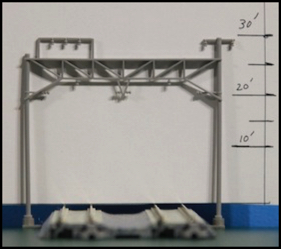
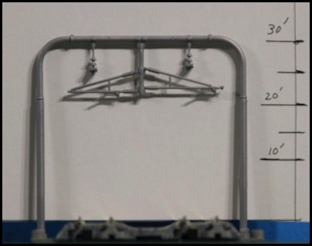
Kato 23-060 (pole and truss) and 23-057 (curved) catenary
Kato’s double-track catenary poles include both older “truss” designs that are clearly low-voltage (23-060, narrow base, and 23-061 wide base) and newer tubular pole designs that are more ambiguous (23-057, narrow base, and 23-062, wide base). The 23-061 set reportedly includes the level-ground bases (equivalent to those of the 23-056 set, but longer) and presumably that’s also true of the 23-062, but I don’t own either to verify that.
Finally, in 2011 Kato introduced two new models, a much older truss style double-track pole that uses a box truss for both the pole and the crossbar (23-063, which I believe is a “wide” style) and a four-track post-and-truss design (23-064). I don’t have either of these at present.
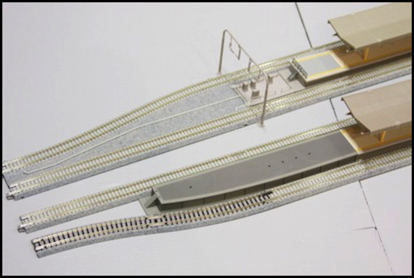
And when Kato introduced the V15 Platform widening set, each end included a very wide catenary pole of the tubular style that spanned both tracks and the platform. This appears to be similar to the 23-062 except for the width. However, the pole is not available separately, which is a nuisance since it otherwise could be used over roofless station platforms.
The Layout
I’m using the “narrow” base poles with my River Crossing scene’s parallel double tracks, to allow the tracks to be placed close together. I had some concern about clearance, but even with my Shinkansen and tilting trains, it seems to work. I used the single poles for the outside loop (intended to represent a Shinkansen line, at least part of the time) and the pole-and-truss style double-track poles on the inner loop (intended to represent a commuter line). The two different kinds of poles also explains why a four-track catenary structure isn’t in use, and provides some visual complexity.
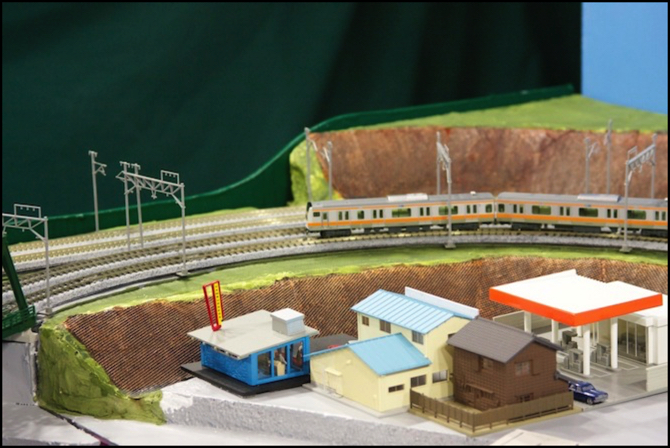
River Crossing Tracks
On of the things that impelled me to write this week’s post is that I’m now working on finishing up the River Crossing scene, and part of this involves painting the catenary poles. I’ll have more to say on that in a future post, after it’s done.
There is more information about Kato’s catenary poles in my Modeling Catenary section, and more prototype photos in the reference sections Catenary Images page.



